Orthopedic specialists and regenerative medicine offer solutions to people facing challenges related to injuries or disorders in their bones, muscles, or joints. These are often treated with pain medication, steroids, and surgery. When combined with regenerative medicine, it opens doors to newer, minimally invasive treatment options. This article will cover the basics of orthopedics and regenerative medicine.
What is Orthopedics?
Orthopedics focuses on the musculoskeletal system, which includes bones, muscles, joints, and associated structures. This specialty addresses injuries, deformities, and degenerative conditions such as arthritis. It also covers acute damage resulting from accidents, chronic pain in joints, and issues like tendinitis.
Orthopedic specialists offer care that ranges from non-invasive solutions such as physical therapy and bracing. If that’s not enough, you might switch to more advanced interventions, such as surgical procedures. Orthopedic specialists assist in restoring mobility, managing pain, and enhancing overall musculoskeletal function.
These specialists commonly treat fractures, breaks, and dislocations, as well as degenerative issues. Orthopedists utilize imaging, physical exams, and specialized tests to diagnose conditions effectively. Orthopedic care creates opportunities for improvement in function and quality of life for those who need extra care and support.
Regenerative Medicine in Orthopedics
Regenerative medicine applies biological processes to repair or regenerate damaged tissues. It works alongside conventional orthopedic techniques to address complications from chronic injuries or degenerative conditions. This approach emphasizes restoring tissues rather than merely managing symptoms.
Connective tissues such as cartilage, tendons, and ligaments sometimes heal slowly due to limited blood supply. Regenerative medicine uses techniques like cell-based therapies and biological injections to support recovery. Some examples of regenerative procedures include:
- Platelet-Rich Plasma (PRP): Platelets from a patient’s blood are concentrated and injected into an affected area to promote tissue recovery.
- Stem Cell Therapy: Stem cells, derived from a patient’s bone marrow or fat tissue, are used to assist with healing damaged tissue.
- Cellular Grafting: Cells are applied to areas with reduced function to encourage regeneration.
These applications are often paired with rehabilitation methods, enabling individuals to regain maximum movement. Ongoing medical research continues to expand the capabilities of regenerative medicine, making it an evolving and promising aspect of orthopedic care.
The Role of an Orthopedic Specialist
Orthopedic specialists diagnose, manage, and treat conditions related to the musculoskeletal system. They focus on tailoring treatment plans to an individual’s needs. These specialists often guide patients through the complexities of both traditional and regenerative treatments.
For those with spinal injuries, an orthopedist might recommend targeted therapies or regenerative techniques. These will help to improve mobility and alleviate discomfort. Similarly, joint pain or ligament damage may benefit from advanced approaches like PRP or stem cell therapies. Their expertise lies in understanding how each treatment aligns with a patient’s unique condition and recovery goals.
Finding Orthopedic Specialists
Orthopedics and regenerative medicine combine to address a wide spectrum of injuries and conditions in the musculoskeletal system. Orthopedics supports structural repair and recovery, while regenerative techniques emphasize restoring tissues at a biological level. Orthopedic specialists play a pivotal role in guiding individuals through comprehensive treatment plans.
Keep an eye for more news & updates on TribuneIndian!




